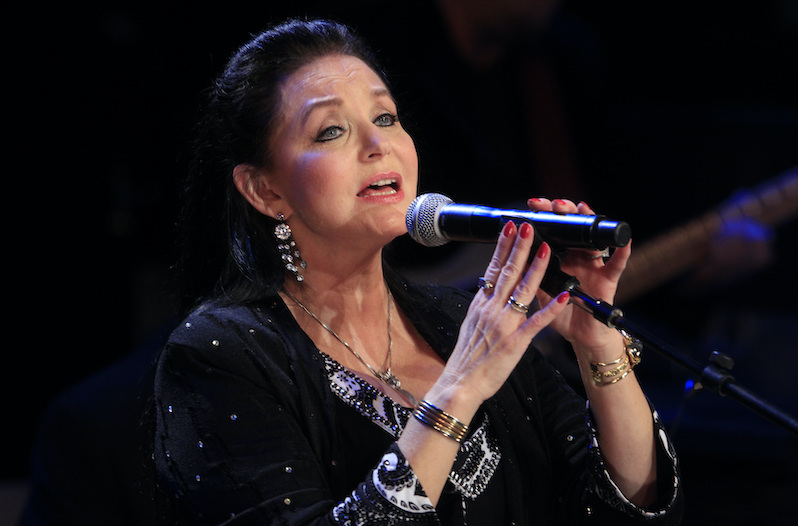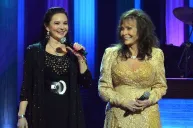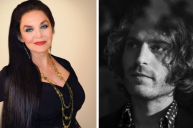One of the more under-appreciated albums of 2019, You Don't Know Me: Classic Country, allowed Grand Ole Opry member and Hollywood Walk of Fame honoree Crystal Gayle to revisit the music of her childhood with her son, Nashville producer and engineer Christos Gatzimos.
To further connect with family, the former Brenda Gail Webb incorporated the talents of three of her seven siblings. Covers included not just the work of Willie Nelson ("Hello Walls"), Hank Williams ("You Win Again") and George Jones ("Just One More") but also her brother, fellow country singer Jay Lee Webb ("You Never Were Mine"). To honor the women who paved Gayle's country music path, she covered Dolly Parton co-write "Put It Off Until Tomorrow" with older sisters Peggy Sue and Loretta Lynn.
These selections open up discussion about Gayle's early career, including when her sister Loretta and brother-in-law Doolittle Lynn landed Gayle a deal with Decca Records. The Lynn family also helped pick out the stage name Crystal Gayle, inspired by Krystal hamburgers and necessitated by Brenda Lee's spot on the Decca roster.
"It was music like the first song I sang on the Opry, 'Ribbon of Darkness'," Gayle says of the track listing. "I was 17 or in that age range. I got to do the performance because my sister Loretta Lynn was sick, and Mooney talked the Opry into letting me go on and sing a song. I sang the song Marty Robbins had a big hit on. Later, when I started my own touring, I opened for Marty and Jack Greene and Faron Young. I look back, and to be in these icon's lives was pretty great."
Not everyone with memories of Gayle's music associates her with classic country hits. Like Eddie Rabbitt, the late Kenny Rogers and, later on, her future duet partner Gary Morris, Gayle knew her history, but she saw fiscal sense in cutting country songs with broader appeal.
The notion that crossover country singles like "Wrong Road Again" (1974), "I'll Get Over You" (1976), "Talking in Your Sleep" (1978), "When I Dream" (1979), "Half the Way" (1979) and "You and I" (1982) were the way to go came from Lynn, not a money-minded music industry type. Deeper cuts of note include "We Must Believe in Magic," the title track from the 1977 album that brought us "Don't It Make My Brown Eyes Blue," and Gayle's work with Tom Waits for the One From The Heart (1982) soundtrack.
"My sister gave me the best advice: 'Don't sing my songs, and don't record anything I would. You go middle of the road'," Gayle says.
Middle of the road worked for a couple of reasons. One, Gayle grew up singing songs by everyone from Billie Holiday to Johnny Cash, so she was used to not limiting herself to a strict definition of "country." Also, her second major label deal with United Artists paired her with a crossover country visionary in songwriter and producer Allen Reynolds.
"I couldn't have had more luck on my side," Gayle explains. "They put me with one of the best writers and song people... Just a great person. You probably know him from his work with Garth Brooks."
The country music business in the '70's evolved in the same direction Gayle headed with Reynolds. By 1977, the pair scored a signature tune and a Grammy with "Don't It Make My Brown Eyes Blue." Gayle already having blue eyes became a common piece of celebrity trivia, but who's to say she wasn't revisiting a character from Lynn composition "I've Cried (The Blue Right Out of My Eyes)?"
The success of "Brown Eyes" helped solidify Gayle's spot in the music business through such honors as the CMA awards' Female Artist of the Year (won in '77-'78), the ACM (Academy of Country Music) prize for Top Female Vocalist ('76, '77 and '79) and the American Music Awards' Favorite Female Country Artist ('79, '80 and '86) and Favorite Female Video Artist ('86).
As with the music of today, Gayle's hits defined country music for her fans. For others, her songs were quite the pop departure from the music of Lynn and her close friend Patsy Cline.
"I always say that the country music that's out there now, the people that are listening to it and loving it are going to look back on it and say, 'That's my country music'," Gaye says. "We don't want to lose the real country music, but things change. When I started out, country music was a small town, and I don't mean Nashville. It was a small community. A hit was what, 50,000? It wasn't this huge pop world that happened with 'Brown Eyes' and Kenny Rogers."
Beyond taking country music mainstream years before Urban Cowboy reached your local theater, Gayle played an understated role in the '90's country music boom as a regular on TNN's The Statler Brothers Show.
Gayle's role on a show featuring its namesakes and underrated vocalist Ronna Reeves found her singing mailed-in requests ranging from Patti Page standards to a certain challenge from the Osborne Brothers' catalog.
"The hardest song for me to ever sing was 'Kentucky,' that bluegrass song that you sing off.," she explains. "I'm not bluegrass, so that took a while. The groove of it was like, 'Okay, when do I come in?,' and I never have that problem."
The series brought Gayle's trademark look, including raven-black hair that hangs down to her ankles, to living rooms across America.
While growing up in Wabash, Indiana, not the rural Kentucky hollow made famous by Lynn's "Coal Miner's Daughter," circumstances dictated a much different hairstyle for Gayle.
"My mother always kept my hair really short because she worked," she says. "She couldn't fix it. She did a lot of the midnight shifts, and she worked at a nursing home and a home for children... I wanted hair long enough to put into a ponytail. When I got old enough to take care of it myself, she let me grow my hair longer."
Mom was onto something beyond keeping hair care to a minimum, based one of Gayle's memories.
"The worst part was going downstairs," Gayle says. "If I forget, people would step on it. I lost a lot of hair that way, and I don't mean two or three hairs. That's a way to thin out your hair!"
Now Watch: Kenny Rogers' Greatest Vocal Performances Through the Years




